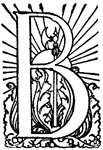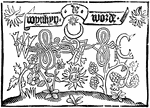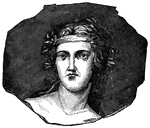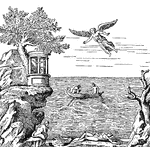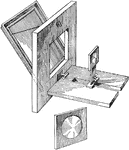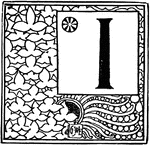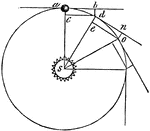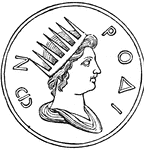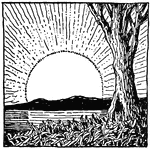
Seal of Alaska
The Seal of the District of Alaska, 1911. The image on the seal shows Alaska's mountains and shore.

Aradus
This medal shows that the people of Aradus venerated the sun, and were proud of the products of their…
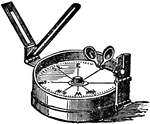
Azimuth Compass
"At sea the declination is generally observed by means of an azimuth compass invented by Kater. It consists…

Captain of a Ship
A captain on his ship. "At high noon every day he makes an observation, telling by the sun just where…
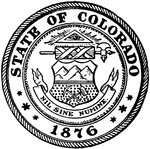
Seal of Colorado
The Seal of Colorado, 1876. The seal shows The Eye of Providence and Colorado's motto 'Nil sine numine'…

Ring Dial
A kind of portable sundial, consisting of a metal ring, broad in proportion to its diameter, and having…
Diminish Shadow
"Since A is producing light and larger than object B, the shadow of B continuously shrinks to a single…
Divider with Leaves and Sun Rays
This divider has leaves and small round kernels featured in a design on the sides. The center area has…
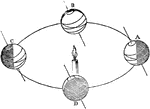
Earth Axis
"Now it is the inclination of the Earth's axis, as above described, which causes the lengths of the…

Earth Axis
"Now it is the inclination of the Earth's axis, as above described, which causes the lengths of the…
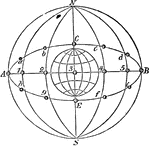
Suns in the Equator and Ecliptic
"Were the Earth's orbit a perfect circle, and her axis perpendicular to the plane of this orbit, the…
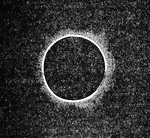
Eclipse
"An Eclipse is an interception or obscuration of the light of the sun, moon, or other heavenly body…

Elliptical Orbit
"The elliptical circle being supposed to be the Earth's orbit, with the Sun, S, in one of the foci.…
Spring Equinox and Autumn Equinox
"Relative positions of the earth and the sun on March 21 (spring equinox) and September 21 (autumn equinox)…

Heliotropium
The heliotropes (Heliotropium) is a genus of plants in the family Boraginaceae with 250 to 300 species.…

Make Hay While the Sun Shines
"In Summer heat, when brightly shines the sun, / To make your hay, the proper time is come: / Spread…

Medal of Gebal
The only medal known to inscribe the name of the town. It depicts a crab, which holds in its claws the…
Moon Eclipse
"When the Moon falls into the shadow of the Earth, the rays of the Sun are intercepted, or hid from…

Moon Phases
"Let S be the Sun, E the Earth, and A, B, C, D, F, the Moon in different parts of her orbit. Now when…
Neap Tides
"The elevation of the tides at c and d is produced by the causes already explained; but their elevation…

Finding the North Star
"Two stars in the Big Dipper opposite the handle indicate the direction toward the North Star, which,…

Osiris
"Osiris was worshipped as the god of the sun, the source of warmth, life, and fruitfulness, in addition…

Phaethon
"Then Phaethon beheld the world on fire, and felt the heat intolerable. The air he breathed was like…

Planet Distance
"Relative distance of the Planets. Having now given a short account of each planet composing the solar…
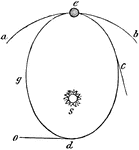
Planet Motion
"Elliptical Orbits.—It has been supposed that the Sun's attraction, which constitutes the Earth's…
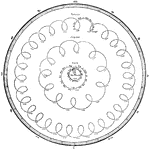
Planet Rotations
"The motion of Saturn, Jupiter, and Mars with respect to Earth." — Encyclopedia Britanica, 1893
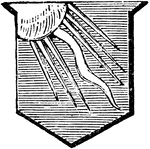
Ray of Sun
"Azure, a ray of the sun issuing out of the dexter corner of the escutcheon. The lines on each side…
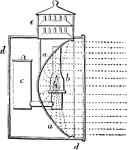
Parabolic, Reflector
A polished surface of metal, or any other suitable material, applied for the purpose of reflecting rays…

Rose-en-Soleil
"The rose argent of the House of York, surrounded with rays, as of the sun."—Aveling, 1891

Seasons from Earth's Orbit
"Relative positions of the earth and the sun during the spring equinox, the summer solstice, the autumn…
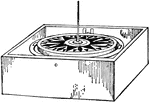
Shadow Pin
"A slender length of brass resting in a small brass button and designed to stand vertically on the center…

Solar Spectrum
"Solar Spectrum.—If a ray, proceeding from the sun, be admitted into a darkened chamber, through…

Summer Solstice
"Relative positions of the earth and the sun on June 21, the summer solstice. Summer and long days north…

Winter Solstice
"Relative positions of the earth and the sun on December 21, the winter solstice. Winter and short days…
Sun Eclipse
"When the moon psses between the Earth and Sun, there happens an eclipse of the Sun, because then the…
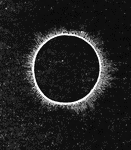
Corona of the Sun
"Corona (a crown) in astronomy is a halo or luminous circle round one of the heavenly bodies; specifically…

